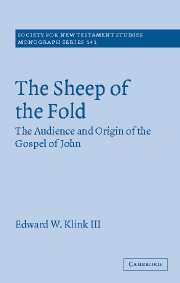Book contents
- Frontmatter
- Contents
- Acknowledgments
- List of abbreviations
- 1 The audience and origin of the Gospels: introduction and method
- 2 Early Christian community: a study of the community construct and its functional potential in early Christianity
- 3 Early Christian Gospel: Gospel genre and a critique of the two-level reading of the Gospel of John
- 4 Early Christian reader: an explication of the audience of the fourth Gospel by inquiring for the implied reader
- 5 Reading the fourth Gospel: the function of the Gospel of John in light of the Gospel community debate
- 6 The sheep of the fold: summary and conclusion
- Bibliography
- Index
2 - Early Christian community: a study of the community construct and its functional potential in early Christianity
Published online by Cambridge University Press: 22 September 2009
- Frontmatter
- Contents
- Acknowledgments
- List of abbreviations
- 1 The audience and origin of the Gospels: introduction and method
- 2 Early Christian community: a study of the community construct and its functional potential in early Christianity
- 3 Early Christian Gospel: Gospel genre and a critique of the two-level reading of the Gospel of John
- 4 Early Christian reader: an explication of the audience of the fourth Gospel by inquiring for the implied reader
- 5 Reading the fourth Gospel: the function of the Gospel of John in light of the Gospel community debate
- 6 The sheep of the fold: summary and conclusion
- Bibliography
- Index
Summary
The quest for the early Christian “community”
The quest for the historical Jesus that occupied much of the nineteenth century largely gave way to the quest for the early church in the twentieth century. As we saw in chapter 1, the focus on the communities of the early church, though undefined, was considered by the initial form critics to be the only historical remnant left to be sought. The historical results determined by the form critics were in many ways sociological in nature. The basic methodology used by Bultmann and the other early form critics was an idea taken from the sociology of literature, namely that certain types of literature or genres (Gattungen) are bound to and shaped by specific types of social life-settings (Sitze im Leben). Literary genre is a social category of communication; the questions being asked of the text were sociological. The communities in which the Gospel texts were created had various functions which determined the forms and overall use of the Jesus tradition and its eventual Gospel text form.
Although the initial sociological emphasis in form criticism looked promising, the sociological potential was never developed. Thomas Best argues that, “it cannot be denied that even form criticism, with all its talk of the Sitz-im-Leben (life-setting) of the text, was a literary and theological discipline which produced hardly any concrete historical, social, or economic information about the traditions which it studied”.
- Type
- Chapter
- Information
- The Sheep of the FoldThe Audience and Origin of the Gospel of John, pp. 42 - 106Publisher: Cambridge University PressPrint publication year: 2007



